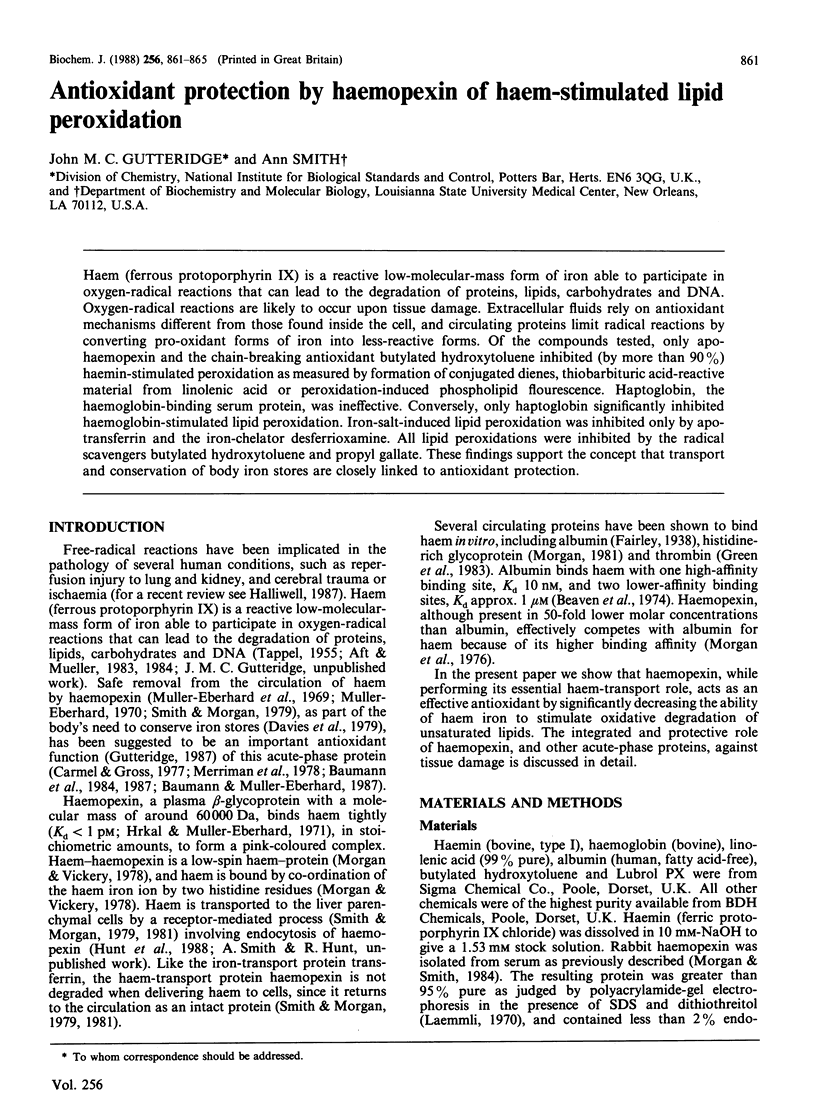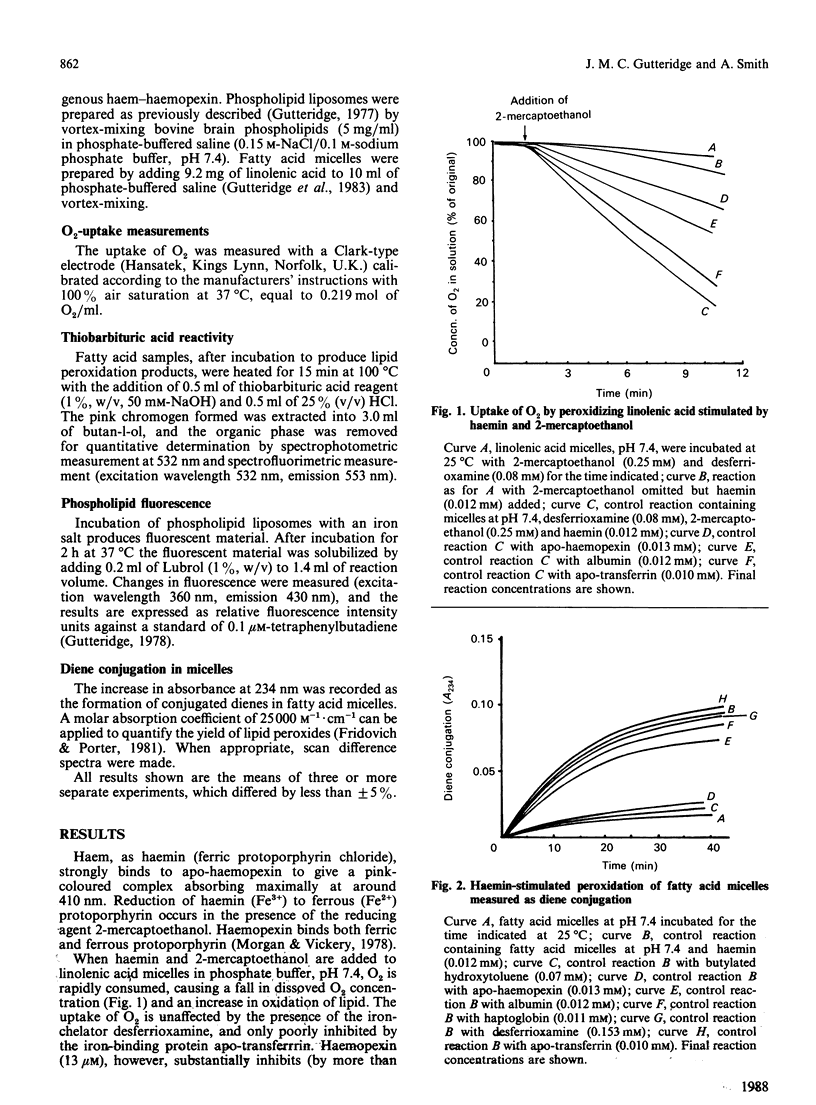Abstract
Haem (ferrous protoporphyrin IX) is a reactive low-molecular-mass form of iron able to participate in oxygen-radical reactions that can lead to the degradation of proteins, lipids, carbohydrates and DNA. Oxygen-radical reactions are likely to occur upon tissue damage. Extracellular fluids rely on antioxidant mechanisms different from those found inside the cell, and circulating proteins limit radical reactions by converting pro-oxidant forms of iron into less-reactive forms. Of the compounds tested, only apohaemopexin and the chain-breaking antioxidant butylated hydroxytoluene inhibited (by more than 90%) haemin-stimulated peroxidation as measured by formation of conjugated dienes, thiobarbituric acid-reactive material from linolenic acid or peroxidation-induced phospholipid fluorescence. Haptoglobin, the haemoglobin-binding serum protein, was ineffective. Conversely, only haptoglobin significantly inhibited haemoglobin-stimulated lipid peroxidation. Iron-salt-induced lipid peroxidation was inhibited only by apotransferrin and the iron-chelator desferrioxamine. All lipid peroxidations were inhibited by the radical scavengers butylated hydroxytoluene and propyl gallate. These findings support the concept that transport and conservation of body iron stores are closely linked to antioxidant protection.
Full text
PDF




Selected References
These references are in PubMed. This may not be the complete list of references from this article.
- Aft R. L., Mueller G. C. Hemin-mediated DNA strand scission. J Biol Chem. 1983 Oct 10;258(19):12069–12072. [PubMed] [Google Scholar]
- Aft R. L., Mueller G. C. Hemin-mediated oxidative degradation of proteins. J Biol Chem. 1984 Jan 10;259(1):301–305. [PubMed] [Google Scholar]
- Baumann H., Held W. A., Berger F. G. The acute phase response of mouse liver. Genetic analysis of the major acute phase reactants. J Biol Chem. 1984 Jan 10;259(1):566–573. [PubMed] [Google Scholar]
- Baumann H., Muller-Eberhard U. Synthesis of hemopexin and cysteine protease inhibitor is coordinately regulated by HSF-II and interferon-beta 2 in rat hepatoma cells. Biochem Biophys Res Commun. 1987 Aug 14;146(3):1218–1228. doi: 10.1016/0006-291x(87)90778-9. [DOI] [PubMed] [Google Scholar]
- Baumann H., Onorato V., Gauldie J., Jahreis G. P. Distinct sets of acute phase plasma proteins are stimulated by separate human hepatocyte-stimulating factors and monokines in rat hepatoma cells. J Biol Chem. 1987 Jul 15;262(20):9756–9768. [PubMed] [Google Scholar]
- Beaven G. H., Chen S. H., d' Albis A., Gratzer W. B. A spectroscopic study of the haemin--human-serum-albumin system. Eur J Biochem. 1974 Feb 1;41(3):539–546. doi: 10.1111/j.1432-1033.1974.tb03295.x. [DOI] [PubMed] [Google Scholar]
- Carmel N., Gross J. Hemopexin metabolism in mice with transplantable tumors. Isr J Med Sci. 1977 Dec;13(12):1182–1190. [PubMed] [Google Scholar]
- Davies D. M., Smith A., Muller-Eberhard U., Morgan W. T. Hepatic subcellular metabolism of heme from heme-hemopexin: incorporation of iron into ferritin. Biochem Biophys Res Commun. 1979 Dec 28;91(4):1504–1511. doi: 10.1016/0006-291x(79)91235-x. [DOI] [PubMed] [Google Scholar]
- Fridovich S. E., Porter N. A. Oxidation of arachidonic acid in micelles by superoxide and hydrogen peroxide. J Biol Chem. 1981 Jan 10;256(1):260–265. [PubMed] [Google Scholar]
- Green D., Reynolds N., Klein J., Kohl H., Ts'ao C. H. The inactivation of hemostatic factors by hematin. J Lab Clin Med. 1983 Sep;102(3):361–369. [PubMed] [Google Scholar]
- Gutteridge J. M. Age pigments and free radicals: fluorescent lipid complexes formed by iron- and copper-containing proteins. Biochim Biophys Acta. 1985 Apr 25;834(2):144–148. doi: 10.1016/0005-2760(85)90149-3. [DOI] [PubMed] [Google Scholar]
- Gutteridge J. M., Beard A. P., Quinlan G. J. Superoxide-dependent lipid peroxidation. Problems with the use of catalase as a specific probe for fenton-derived hydroxyl radicals. Biochem Biophys Res Commun. 1983 Dec 28;117(3):901–907. doi: 10.1016/0006-291x(83)91681-9. [DOI] [PubMed] [Google Scholar]
- Gutteridge J. M. Fate of oxygen free radicals in extracellular fluids. Biochem Soc Trans. 1982 Apr;10(2):72–73. doi: 10.1042/bst0100072. [DOI] [PubMed] [Google Scholar]
- Gutteridge J. M. Iron promoters of the Fenton reaction and lipid peroxidation can be released from haemoglobin by peroxides. FEBS Lett. 1986 Jun 9;201(2):291–295. doi: 10.1016/0014-5793(86)80626-3. [DOI] [PubMed] [Google Scholar]
- Gutteridge J. M., Paterson S. K., Segal A. W., Halliwell B. Inhibition of lipid peroxidation by the iron-binding protein lactoferrin. Biochem J. 1981 Oct 1;199(1):259–261. doi: 10.1042/bj1990259. [DOI] [PMC free article] [PubMed] [Google Scholar]
- Gutteridge J. M., Stocks J. Caeruloplasmin: physiological and pathological perspectives. Crit Rev Clin Lab Sci. 1981;14(4):257–329. doi: 10.3109/10408368109105866. [DOI] [PubMed] [Google Scholar]
- Gutteridge J. M. The antioxidant activity of haptoglobin towards haemoglobin-stimulated lipid peroxidation. Biochim Biophys Acta. 1987 Feb 14;917(2):219–223. doi: 10.1016/0005-2760(87)90125-1. [DOI] [PubMed] [Google Scholar]
- Gutteridge J. M. The measurement of malondialdehyde in peroxidised ox-brain phospholipid liposomes. Anal Biochem. 1977 Sep;82(1):76–82. doi: 10.1016/0003-2697(77)90136-1. [DOI] [PubMed] [Google Scholar]
- Gutteridge J. M. The membrane effects of vitamin E, cholesterol and their acetates on peroxidative susceptibility. Res Commun Chem Pathol Pharmacol. 1978 Dec;22(3):563–572. [PubMed] [Google Scholar]
- Halliwell B., Gutteridge J. M. Oxygen free radicals and iron in relation to biology and medicine: some problems and concepts. Arch Biochem Biophys. 1986 May 1;246(2):501–514. doi: 10.1016/0003-9861(86)90305-x. [DOI] [PubMed] [Google Scholar]
- Halliwell B. Oxidants and human disease: some new concepts. FASEB J. 1987 Nov;1(5):358–364. [PubMed] [Google Scholar]
- Hrkal Z., Muller-Eberhard U. Partial characterization of the heme-binding serum glycoproteins rabbit and human hemopexin. Biochemistry. 1971 May 11;10(10):1746–1750. doi: 10.1021/bi00786a002. [DOI] [PubMed] [Google Scholar]
- Laemmli U. K. Cleavage of structural proteins during the assembly of the head of bacteriophage T4. Nature. 1970 Aug 15;227(5259):680–685. doi: 10.1038/227680a0. [DOI] [PubMed] [Google Scholar]
- Marklund S. L., Holme E., Hellner L. Superoxide dismutase in extracellular fluids. Clin Chim Acta. 1982 Nov 24;126(1):41–51. doi: 10.1016/0009-8981(82)90360-6. [DOI] [PubMed] [Google Scholar]
- Merriman C. R., Upchurch H. F., Kampschmidt R. F. Effects of leukocytic endogenous mediator on hemopexin, transferr, and liver catalase. Proc Soc Exp Biol Med. 1978 Apr;157(4):669–671. doi: 10.3181/00379727-157-40118. [DOI] [PubMed] [Google Scholar]
- Morgan W. T. Interactions of the histidine-rich glycoprotein of serum with metals. Biochemistry. 1981 Mar 3;20(5):1054–1061. doi: 10.1021/bi00508a002. [DOI] [PubMed] [Google Scholar]
- Morgan W. T., Liem H. H., Sutor R. P., Muller-Ebergard U. Transfer of heme from heme-albumin to hemopexin. Biochim Biophys Acta. 1976 Sep 24;444(2):435–445. doi: 10.1016/0304-4165(76)90387-1. [DOI] [PubMed] [Google Scholar]
- Morgan W. T., Smith A. Domain structure of rabbit hemopexin. Isolation and characterization of a heme-binding glycopeptide. J Biol Chem. 1984 Oct 10;259(19):12001–12006. [PubMed] [Google Scholar]
- Morgan W. T., Vickery L. E. Magnetic and natural circular dichroism of metalloporphyrin complexes of human and rabbit hemopexin. J Biol Chem. 1978 May 10;253(9):2940–2945. [PubMed] [Google Scholar]
- Muller-Eberhard U. Hemopexin. N Engl J Med. 1970 Nov 12;283(20):1090–1094. doi: 10.1056/NEJM197011122832007. [DOI] [PubMed] [Google Scholar]
- Muller-Eberhard U., Liem H. H., Hanstein A., Saarinen P. A. Studies on the disposal of intravascular heme in the rabbit. J Lab Clin Med. 1969 Feb;73(2):210–218. [PubMed] [Google Scholar]
- Sadrzadeh S. M., Graf E., Panter S. S., Hallaway P. E., Eaton J. W. Hemoglobin. A biologic fenton reagent. J Biol Chem. 1984 Dec 10;259(23):14354–14356. [PubMed] [Google Scholar]
- Smith A., Morgan W. T. Haem transport to the liver by haemopexin. Receptor-mediated uptake with recycling of the protein. Biochem J. 1979 Jul 15;182(1):47–54. doi: 10.1042/bj1820047. [DOI] [PMC free article] [PubMed] [Google Scholar]
- Smith A., Morgan W. T. Hemopexin-mediated transport of heme into isolated rat hepatocytes. J Biol Chem. 1981 Nov 10;256(21):10902–10909. [PubMed] [Google Scholar]
- TAPPEL A. L. Unsaturated lipide oxidation catalyzed by hematin compounds. J Biol Chem. 1955 Dec;217(2):721–733. [PubMed] [Google Scholar]
- Takahashi K., Avissar N., Whitin J., Cohen H. Purification and characterization of human plasma glutathione peroxidase: a selenoglycoprotein distinct from the known cellular enzyme. Arch Biochem Biophys. 1987 Aug 1;256(2):677–686. doi: 10.1016/0003-9861(87)90624-2. [DOI] [PubMed] [Google Scholar]


